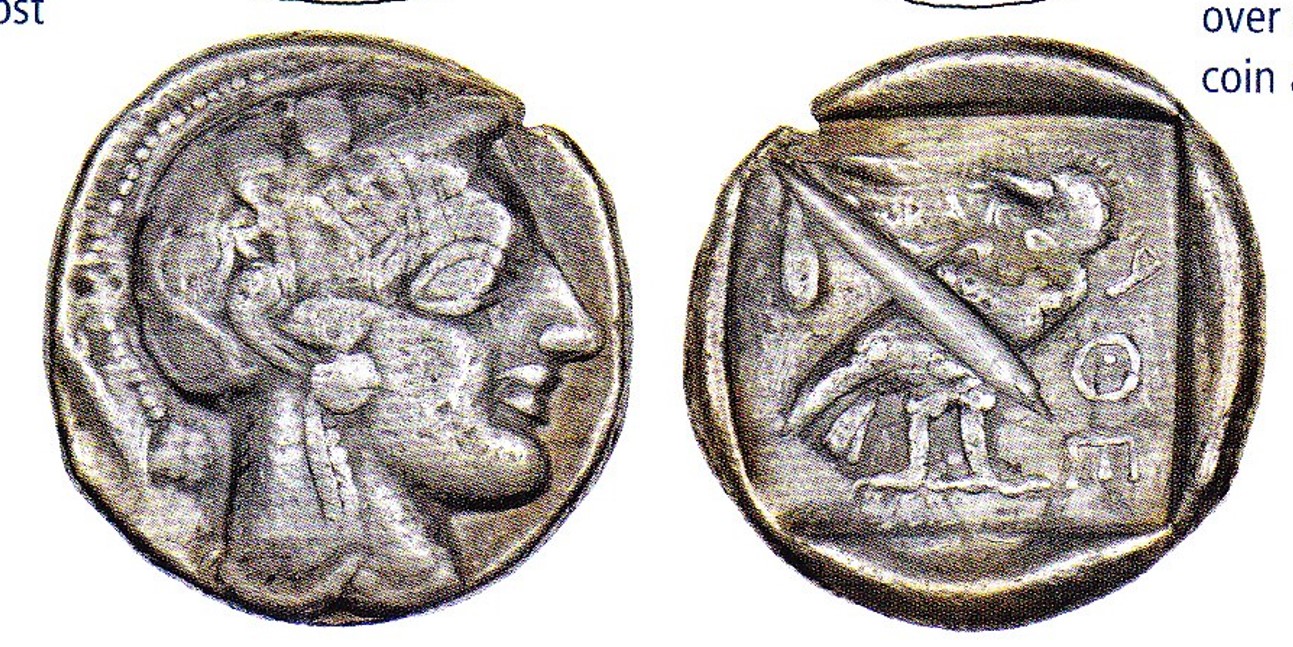3142 - Athens (tetradrachm Athena/owl) over Syracuse (quadriga/Arethusa) (MacDonald coll., 109)
From SILVER
461 BCE - 454 BCE | AΘE
Images
Overstruck variety Traces of the overstruck variety
Traces of the overstruck variety

Ref_syracuse.png [1]
Location/history
| Private collection(s)Private collection(s) ᵖ: | MacDonald coll. n° 109 |
Overstriking coin
Description
| ObverseInscription or printing placed on the obverse.: | Head of Athena right, wearing crested Attic helmet. Border of dots. | ReverseInscription or printing placed on the reverse.: | AΘE (Greek) Owl right. Behind, olive spring and cescent. |
Mint and issuing power
| MintIdentifies the place of manufacture or issue of a numismatic object.: | Athens | Ancient regionAncient region. | Attica | Modern countryModern country: Greece | AuthorityIdentifies the issuing power. The authority can be "pretended" when the name or the portrait of X is on the coin but he/she was not the issuing power. It can also be "uncertain" when there is no mention of X on the coin but he/she was the issuing power according to the historical sources: |
Chronology
| FromIdentifies the initial date in a range assigned in a numismatic context. 461 BCE toIdentifies the final date in a range assigned in a numismatic context.. 454 BCE | Classical 480-323 BC |
Physical description
| MetalThe physical material (usually metal) from which an object is made.: Silver |
WeightWeight of the numismatic object (in grams). in grams: 17.1817.18 g <br />17,180 mg <br /> | DenominationTerm indicating the value of a numismatic object. Examples: tetradrachm, chalkous, denarius.: tetradrachm |
AxisDescribes the directional relationship between the obverse and reverse of a numismatic object.: 1212 mm <br />1.2 cm <br /> |
| StandardStandard.: Attic | |||
References
| Coin referenceReference of the Coin: | MacDonald 2009, p. 148, n° 109 | Coin series referenceReference to coin series study: | Starr 19701Starr 1970, Group V, MacDonald 20092MacDonald 2009, p. 148, n° 109, HGC 43HGC 4, n° 1596 |
| Coin series web referenceCoin series web references: | |||
Overstruck type
Description
| ObverseInscription or printing placed on the obverse.: | Quadriga right. Above, Nike right | ReverseInscription or printing placed on the reverse.: | ΣΥΡΑΚΟΣΙΩΝ (Greek) Head of Aretusa right surrounded by four dolphins |
Mint and issuing power
| MintIdentifies the place of manufacture or issue of a numismatic object. ᵖ: | Syracuse | Ancient regionAncient region. ᵖ | Magna Graecia (Sicily) | Modern countryModern country: Italy | AuthorityIdentifies the authority in whose name (explicitly or implicitly) a numismatic object was issued. ᵖ: |
Chronology
| FromIdentifies the initial date in a range assigned in a numismatic context. 460 BCE toIdentifies the final date in a range assigned in a numismatic context.. 440 BCE | Classical 480-323 BC |
Physical description
| DenominationTerm indicating the value of a numismatic object. Examples: tetradrachm, chalkous, denarius. ᵖ: | tetradrachm |
StandardStandard. ᵖ: | Attic |
References
| Coin type referenceReference to coin series study ᵖ: | Boehringer 19294Boehringer 1929, Group III, VIIIb (R104). | ||
| Coin series web reference overstruckCoin series web references overstruck: | |||
Additional data
| Frequency of overstrikesFrequency of overstrikes: | frequent | Level of confidenceLevel of confidence of the identification: | sure |
| RemarksRemarks: | |||
References
- ^ Starr, Chester G. (1970), Athenian Coinage 480-449 B.C., Oxford, 97 p., 26 pl.
- ^ MacDonald, David (2009), Overstruck Greek coins: studies in Greek chronology and monetary theory, Whitman Publishing, Atlanta.
- ^ Hoover, Oliver D. (2014), Handbook of Greek Coinage Series 4. Northern and Central Greece : Achaia Phthiotis, Ainis, Magnesia, Malis, Oita, Perrhaibia, Thessaly, Akarnania, Aitolia, Lokris, Phokis, Boiotia, Euboia, Attica, Megaris and Corinthia, sixth to first centuries BC, Lancaster, lxxi, 563 p.
- ^ Boehringer, Erich (1929), Die Münzen von Syrakus, Berlin-Leipzig, vi, [2], 297 p. : ill. and portfolio of 32 pl. ; 28 cm

